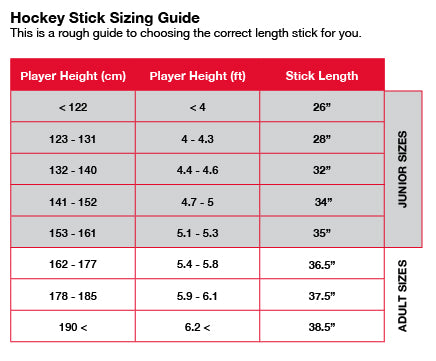FAQ
What is your return policy?
- If you choose the wrong size or colour that’s ok just email us at shop@hockeyinternational.com.au and post it back to us and we will send you a replacement. Good for two returns.
What makes a stick better then another stick?
- The easiest way and most basic way without going into too much detail to differentiate between one stick to another is the amount of carbon. All sticks are made up of a mix of carbon, Kevlar and fibreglass. The more carbon in the stick the stiffer it is, the harder you can hit the ball and the nicer it will feel and for parents unfortunately the more expensive it is. This does not take in to account the knitting system and the process of each stick being made however.
What do all the different curves mean?
- In the modern hockey game there are so many different types of curves or bows in the stick. The more curve in the stick the easier it will be to use stick skills, ball control, 3d skills and overheads. However the more curve in the stick the harder it is to hit and keep the ball flat.
- The straighter the stick the easier it is to hit and slap the ball flat but it wont be as easy to use your stick skills and overheads.
Dedicated hockey shoe versus cross trainer/trail shoe?
- A dedicated hockey shoe is made to out last the heavy workload that hockey players put their shoes through with lateral movement and the abrasive surface we play on. Hockey shoes also offer great grip for players who play on grass.
- Cross trainers/trail shoes have risen to dizzying heights in popularity. They offer the wearer great cushion and support, they are also very light weight for those flat footed forwards that we all know and hate playing against. They however are not as hard wearing as hockey shoes and generally do not last as long as a hockey shoe.
How do I know if I will like the stick?
- If you live in Perth you can come instore and test all our sticks out in our customer built hit up cage.
If I buy a stick and or grip will you put the grip on for me?
- Yes we will. If you ask nicely. We will also do this free of charge. However, if the existing grip is in an unreasonable condition and will take additional time for us to peel off and get ready for the new grip to be fitted you will be asked to pay a small fitting fee.
What handed glove should I use for outdoor hockey?
- Traditionally players will only play with a glove on their left hand. However we have seen a spike in popularity of wanting a right handed glove also.
What handed glove should I use for indoor hockey?
- Indoor hockey payers will generally use just a left handed glove.
How do I know what size hockey stick I need?

There is no visible damage but I think my stick is broken?
- This is a very common issue. Sometimes the end cap is loose or coming loose. To find out hold your stick in the middle of the grip. Bounce it straight up and down on some carpet or something hard but won't damage the bottom of your stick. If it rattles repeat but holding the stick tightly on the end of your stick. If it doesn’t rattle it means the end cap is coming loose. Parents breathe easy this is very fixable. If your stick is still rattling but your end cap is stuck on hard, sometimes there can be some debris that has come loose in the shaft of your stick. This does not necessarily mean your stick is broken but it just needs a new cap and clean out.
